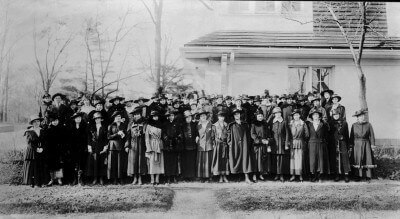Mary Free Bed Guild
In the Name of All Marys
The Mary Free Bed effort dates back to 1891 when a small group of women decided to raise funds to cover the cost of a “free bed” in the Union Benevolent Association Hospital. They came up with a fund-raiser, calling on everyone whose name was Mary, a very popular name at the time, to donate ten cents. And they encouraged everyone to donate in honor of a Mary they knew, family or friend. This free bed took on the name of the Mary Free Bed. A Mary Free Bed committee was formed to continue the support.
In 1911, the committee formalized itself as Mary Free Bed Guild to expand membership hoping to raise enough to support a free bed in the hospital for an entire year. The expanded Guild soon came up with other fund raising ideas, including a benefit concert bringing famous operatic soloists and big-city orchestras to Grand Rapids.
The concerns of the Guild also expanded. Guild-sponsored rehabilitation initially focused on children, with the opening of the first pediatric orthopedic clinic in 1920. The first formally trained physical therapist was brought to town in 1921.
The Guild worked with the Grand Rapids Public Schools in 1923 to establish accessible classrooms for children with disabilities. The Guild’s Children’s Convalescent Home opened in 1930. After being designated the orthopedic center for western Michigan by the Michigan Crippled Children’s Commission in 1934, it was renamed the Mary Free Bed Guild Convalescent Home and Orthopedic Center. A brace shop was established in 1938 and the Juvenile Amputee Training Program developed in 1946 became a national model. Thalidomide and polio crises kept beds filled throughout the mid-20th century.
During these years they began using extra space in the D. A. Blodgett Home for Children and in 1950, the building was deeded to the Guild. In 1951 they opened a new addition to the original D. A. Blodgett building, and in 1953 Mary Free Bed added adult rehabilitation to their programs. By 1961, all rehabilitative care in the area was centralized at Mary Free Bed. Expanded services necessitated more space, so planning for a new building began. The present hospital on Wealthy Street opened in 1976. The venture begun by a very small committee grew to include a $62.5 million flagship hospital, home to 167 inpatients beds, 14 inpatient and 31 outpatient programs, a medical group, and a rehabilitation network which provides expertise throughout Michigan’s Lower Peninsula.
The 120 women of the Guild govern Mary Free Bed Rehabilitation Hospital with majority representation on all boards and committees. In addition to governance, Guild members serve on patient committees, greeting patients when they arrive, distributing small complimentary favors, and polling patients on how to better serve them.
During the past 130+ years, the Guild has created a nationally recognized rehabilitation resource that has made millions of futures better.
Sources
This article can also be found in the Winter 2016 GGRWHC Newsletter.

